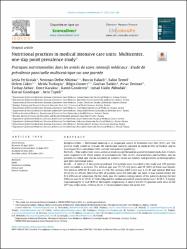| dc.contributor.author | Ferliçolak, Leyla | |
| dc.contributor.author | Altıntaş, Neriman Defne | |
| dc.contributor.author | Halaçlı, Burçin | |
| dc.contributor.author | Temel, Sahin | |
| dc.contributor.author | Zerman, Avşar | |
| dc.contributor.author | Akbudak, Ismail Hakkı | |
| dc.contributor.author | Gündoğan, Kürşat | |
| dc.contributor.author | Topeli, Arzu | |
| dc.date.accessioned | 2023-12-11T08:10:54Z | |
| dc.date.available | 2023-12-11T08:10:54Z | |
| dc.date.issued | 2023 | en_US |
| dc.identifier.citation | Ferlicolak, L., Altintas, N. D., Halacli, B., Temel, S., Cakin, O., Turkoglu, M., ... & Topeli, A. (2023). Nutritional practices in medical intensive care units: Multicenter, one-day point prevalence study. Nutrition Clinique et Métabolisme, 37(4), 221-226. | en_US |
| dc.identifier.issn | 09850562 | |
| dc.identifier.uri | https://doi.org/10.1016/j.nupar.2023.06.002 | |
| dc.identifier.uri | https://hdl.handle.net/20.500.12513/5383 | |
| dc.description.abstract | Background/Aim: Nutritional planning is an important aspect of Intensive Care Unit (ICU) care. The present study aimed to evaluate the nutritional practices adopted in medical ICUs in Turkiye and to investigate their compliance with current international guidelines. Methods: This multicenter, cross-sectional study was performed on a predetermined study date. Centers were required to fill three groups of questionnaires: One on ICU characteristics and facilities, one on patients included, and one on outcomes of patients. Forms on patients had questions on demographics and their nutritional status. Results: A total of 12 sites participated and 132 patients were recorded in the study and 109 patients were included in analyses. The median age was 72 [57–83] years and 55 (50%) of them was female. The median APACHE II score was 23 [18–29], median SOFA score was 6 [4–9] and median BMI was 25.32 [21.22–29.38]. More than 50% of patients were fed enterally; for most, it was started within the first 24 hours of admission. On the study day, the median energy intake of the patients during the last 24 hours was 21.62 [15.9–27.3] kcal/kg and the median amount of protein intake was 1.02 [0.7–1.3] g/kg, representing 83.1% and 78.9% of the targets, respectively. A total of 64 (58.7%) patients were alive on the 28th day of the study, of them 23 (21.1% of all patients) were still in the ICU. Conclusion: Nutrition therapy in medical ICUs was initiated early after ICU admission, the enteral route was preferred and target calories were calculated using weight-based formulas. These results suggest that multi-dimensional planning of critical care management of patients by intensivists may provide better nutritional care for the critically ill. © 2023 Société francophone nutrition clinique et métabolisme (SFNCM) | en_US |
| dc.language.iso | eng | en_US |
| dc.publisher | Elsevier Masson s.r.l. | en_US |
| dc.relation.isversionof | 10.1016/j.nupar.2023.06.002 | en_US |
| dc.rights | info:eu-repo/semantics/openAccess | en_US |
| dc.subject | Adult | en_US |
| dc.subject | Critical care | en_US |
| dc.subject | Enteral nutrition | en_US |
| dc.subject | Parenteral nutrition | en_US |
| dc.title | Nutritional practices in medical intensive care units: Multicenter, one-day point prevalence study | en_US |
| dc.type | article | en_US |
| dc.relation.journal | Nutrition Clinique et Metabolisme | en_US |
| dc.contributor.department | Tıp Fakültesi | en_US |
| dc.contributor.authorID | Avşar Zerman / 0000-0003-0957-0766 | en_US |
| dc.identifier.volume | 37 | en_US |
| dc.identifier.issue | 4 | en_US |
| dc.identifier.startpage | 221 | en_US |
| dc.identifier.endpage | 226 | en_US |
| dc.relation.publicationcategory | Makale - Uluslararası Hakemli Dergi - Kurum Öğretim Elemanı | en_US |


















